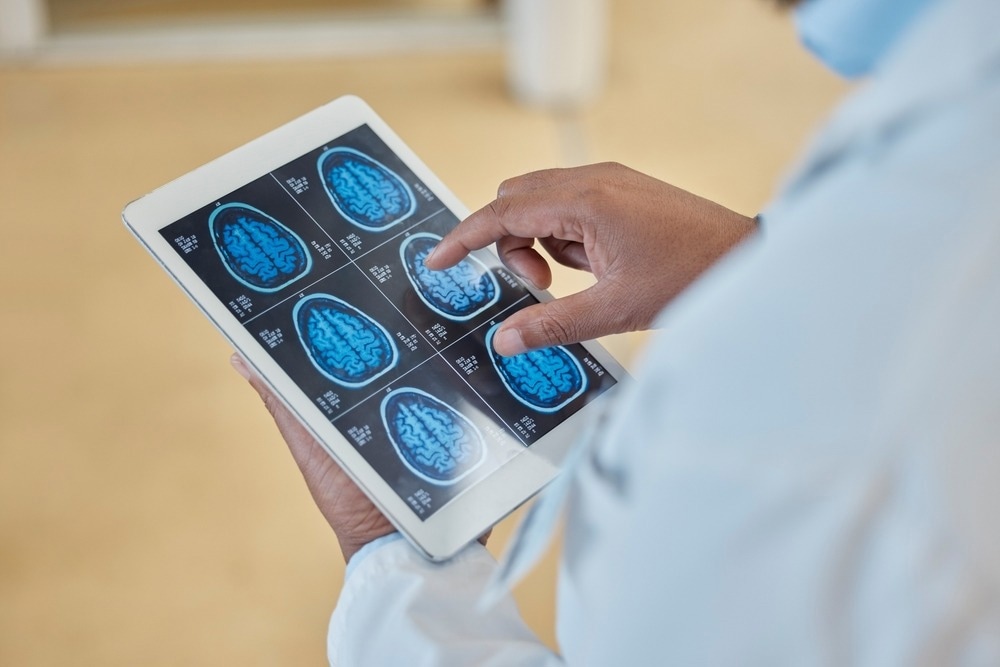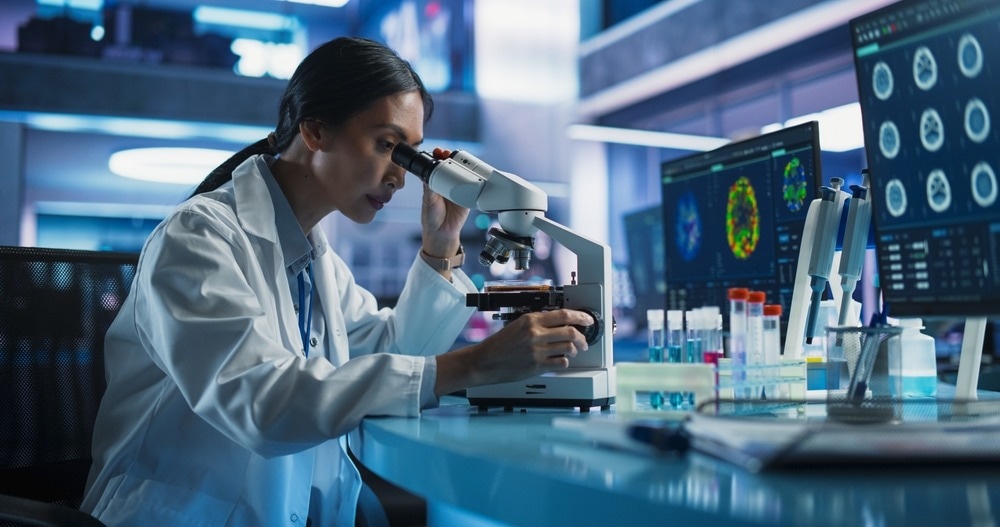What is spatial transcriptomics?
Spatial transcriptomics in neuroscience
Impact on neurological disorder research
Bridging the gap between research and clinical practice
Conclusion: The future of spatial transcriptomics in medicine
References
Further reading
Spatial transcriptomics is a new tool that may prove key to increasing our understanding of tissues and the cellular processes at work in a 3D space. This article describes the basic principles of spatial transcriptomics, alongside its application in neuroscience both cognitively and clinically.

Image Credit: PeopleImages.com - Yuri A/Shutterstock.com
What is spatial transcriptomics?
Applying single-cell RNA sequencing has led researchers to be able to profile the entire transcriptome of cells. However, these transcriptomes prove difficult to link back to their original location during this process. 1 Therefore, to better understand the expression of genes within a spatial environment, new technologies were required to map cellular transcriptomes.
Spatial transcriptomics, however, does not refer to one methodology and is, in fact, made up of five families of techniques, each containing further variation. These families include microdissected gene expression, in situ hybridization (ISH), in situ sequencing (ISS), in situ capturing, and in silico reconstruction of spatial data. 2
Each technique achieves the quantification of the spatial transcriptome of a sample in different ways. Techniques may seek to isolate sections within a sample, such as microdissected gene expression. 2
Other techniques instead may use tagged probes specific to nucleic bases or RNA (ISS and ISH, respectively). These tagged probes then fluoresce under a specific wavelength of light, showing the presence and locale of the targeted RNA/bases. 2
Clinical Applications of Spatial Biology in Disease Diagnosis and Treatment
In situ capturing instead performs the sequencing of transcripts ex vivo, first capturing these transcripts in vivo. This capturing occurs when the section is fixed upon a specialist slide that includes a specialist barcode or microbead. 3
Increasing computational technology is also offering a means to understand spatial transcriptomics. This in silico methodology utilizes disassociated single-cell transcriptomes, which are then mapped back into a 3D space. This mapping can be guided by a reference map, which utilizes gene expression signatures or without, which works based on the assumption of gene expression. 2
First described by Ståhl et al. in 2016, spatial transcriptomics builds on technologies in use since the 1970s to identify and localize the expression of multiple genes. 4,5 Since 2016, further technological developments have been made, whether through the introduction of different techniques or the refinement of existing ones.
In fluorescent ISH, for example, advances have been made to replace the fluorescence on the primary probes with a barcode sequence, allowing them to be targeted by a secondary probe containing the fluorescence. As the primary label is four barcodes, the following secondary label sequences allow for RNA identification. 1 This technique (seqFISH+) has a greater multiplex than its predecessor. 2
Spatial transcriptomics in neuroscience
Applications of spatial transcriptomics in neuroscience are various; however, one area of neuroscience in which this technology has excited researchers is mapping brain architecture. The human brain has been recently shown to contain over 3000 unique cell types. 6 Adding further variables, such as cell state–dependent signatures and how these cells are concentrated spatially, leads to a complex map. 7
Understanding how these cell types are distributed, plus the interactions between them, may provide better insight into brain architecture. Already, spatial transcriptomics has shed light on the spatial organization of the human brain, alongside whole-brain comparisons between rodents and humans. 8
This technology may be used to describe cell types within a brain region. Nociceptors are sensory neurons responsible for detecting harmful stimuli. Research aiming to map these cells in the dorsal root ganglia (DRG) and trigeminal ganglia characterized 12 types of sensory neurons in this area from cell transcriptomes. This research also identified sex differences in the transcriptome of nociceptors. 9
Cell-to-cell communication is another area where spatial transcriptomics has shown promise. Spatial transcriptomics has been shown to return fewer false positives than traditional single-cell RNA sequencing. 10 This has allowed for the mapping of neuronal projections and their interactions, such as in the motor cortex and auditory cortex of mice. 11

Image Credit: Gorodenkoff/Shutterstock.com
Impact on neurological disorder research
Degenerative disorders may benefit greatly from the increasing adoption of spatial transcriptomics. The alteration of spatial organization in the brain provides insight into the produced phenotype alongside the underlying processes. A number of neurodegenerative diseases show large spatial organization, such as Alzheimer’s disease. 7
In Alzheimer’s disease, the use of spatial transcriptomics has revealed a number of processes at work. One such example included the identification of activated microglia near amyloid beta plaques.7
Chen et al. observed that at the early stages of the disease, in oligodendrocytes, myelin-related genes were modulated by the presence of amyloid beta. During later-stage studies, alteration in 57 plaque-induced genes was noted in astrocytes and microglia but also other cellular populations. Crucially, this study’s results describe changes implicated individually across a number of other studies. 12
Alongside degenerative disorders, spatial transcriptomics has also been recently turned towards developmental disorders, such as autism spectrum disorder (ASD). Spatial transcriptomics has demonstrated widespread transcriptomic changes across the cerebral cortex, particularly within the primary visual area. 13 This shows the importance spatial transcriptomics may play in unpicking pathology.
Bridging the gap between research and clinical practice
Accurately identifying cell types may hold the key for treatment in certain conditions. Nociceptors are integral in the production of pain stimuli and thus have been identified as a key target in the treatment of both acute and chronic pain. 14 Understanding the transcription profiles of these cells is key for the selection of correct animal models to use and offering potential biomarker insights. 9
A further application spatial transcriptomics may have is in personalized medicine. Personalized medicine is the practice of tailoring a treatment to the patient (using the patient’s genome) rather than providing blanket treatment for all patients with the same disease. In this way, the disease and patient are treated as one entity, potentially lowering side effects and increasing treatment efficacy.
Spatial transcriptomics may prove useful for assessing the stage a disease may be in, allowing for the selection of drugs or treatments more suitable to that stage, such as cancer. 15 Further to this, they may also prove useful in monitoring the specific response a patient has to a certain treatment regimen, providing accurate date monitoring, which is advantageous for patient management. 16
Conclusion: The future of spatial transcriptomics in medicine
Spatial transcriptomics now offers researchers the unique opportunity to characterize the spatial organization of transcriptomes. As described, this technology has already proved powerful in the description of brain architecture but also offers potential clinical translatability in the study of brain disease and personal medicine applications.
High degrees of success in the application of spatial transcriptomics observed since 2016 suggest it may provide key insights into future scientific research. Combining the aspect of capturing spatial data with this technique alongside other --omic technologies, such as metabolomics and epigenomics, may provide an even greater understanding of spatial architecture or human disease. 4
References
1. Burgess DJ. Spatial transcriptomics coming of age. Nat Rev Genet. 2019;20(6):317-317. doi:10.1038/s41576-019-0129-z
2. Asp M, Bergenstråhle J, Lundeberg J. Spatially Resolved Transcriptomes—Next Generation Tools for Tissue Exploration. BioEssays. 2020;42(10):1-16. doi:10.1002/bies.201900221
3. Tai Q, Yu H, Gao M, Zhang X. In Situ Capturing and Counting Device for the Specific Depletion and Purification of Cancer-Derived Exosomes. Anal Chem. 2023;95(35):13113-13122. doi:10.1021/acs.analchem.3c01670
4. Moses L, Pachter L. Museum of spatial transcriptomics. Nat Methods. 2022;19(5):534-546. doi:10.1038/s41592-022-01409-2
5. Ståhl PL, Salmén F, Vickovic S, et al. Visualization and analysis of gene expression in tissue sections by spatial transcriptomics. Science (80- ). 2016;353(6294):78-82. doi:10.1126/science.aaf2403
6. Chartrand T, Dalley R, Close J, et al. Morphoelectric and transcriptomic divergence of the layer 1 interneuron repertoire in human versus mouse neocortex. Science. 2023;382(6667):eadf0805. doi:10.1126/science.adf0805
7. Lein E, Borm LE, Linnarsson S. The promise of spatial transcriptomics for neuroscience in the era of molecular cell typing. Science (80- ). 2017;358(6359):64-69. doi:10.1126/science.aan6827
8. Beauchamp A, Yee Y, Darwin BC, Raznahan A, Mars RB, Lerch JP. Whole-brain comparison of rodent and human brains using spatial transcriptomics. Elife. 2022;11:1-24. doi:10.7554/eLife.79418
9. Tavares-Ferreira D, Shiers S, Ray PR, et al. Spatial transcriptomics of dorsal root ganglia identifies molecular signatures of human nociceptors. Sci Transl Med. 2022;14(632):1-18. doi:10.1126/scitranslmed.abj8186
10. Walker BL, Cang Z, Ren H, Bourgain-Chang E, Nie Q. Deciphering tissue structure and function using spatial transcriptomics. Commun Biol. 2022;5(1):220. doi:10.1038/s42003-022-03175-5
11. Sun YC, Chen X, Fischer S, et al. Integrating barcoded neuroanatomy with spatial transcriptional profiling enables identification of gene correlates of projections. Nat Neurosci. 2021;24(6):873-885. doi:10.1038/s41593-021-00842-4
12. Chen W-T, Lu A, Craessaerts K, et al. Spatial Transcriptomics and In Situ Sequencing to Study Alzheimer’s Disease. Cell. 2020;182(4):976-991.e19. doi:10.1016/j.cell.2020.06.038
13. Gandal MJ, Haney JR, Wamsley B, et al. Broad transcriptomic dysregulation occurs across the cerebral cortex in ASD. Nature. 2022;611(7936):532-539. doi:10.1038/s41586-022-05377-7
14. Armstrong SA, Herr MJ. Physiology, Nociception. Treasure Island (FL); 2023. http://www.ncbi.nlm.nih.gov/pubmed/27322240.
15. Mubarak G, Zahir FR. Recent Major Transcriptomics and Epitranscriptomics Contributions toward Personalized and Precision Medicine. J Pers Med. 2022;12(2):199. doi:10.3390/jpm12020199
16. Vitali F, Li Q, Schissler AG, Berghout J, Kenost C, Lussier YA. Developing a ‘personalome’ for precision medicine: emerging methods that compute interpretable effect sizes from single-subject transcriptomes. Brief Bioinform. 2019;20(3):789-805. doi:10.1093/bib/bbx149
Further Reading
Last Updated: Jun 27, 2024